jiangsu rongsheng shipyard factory
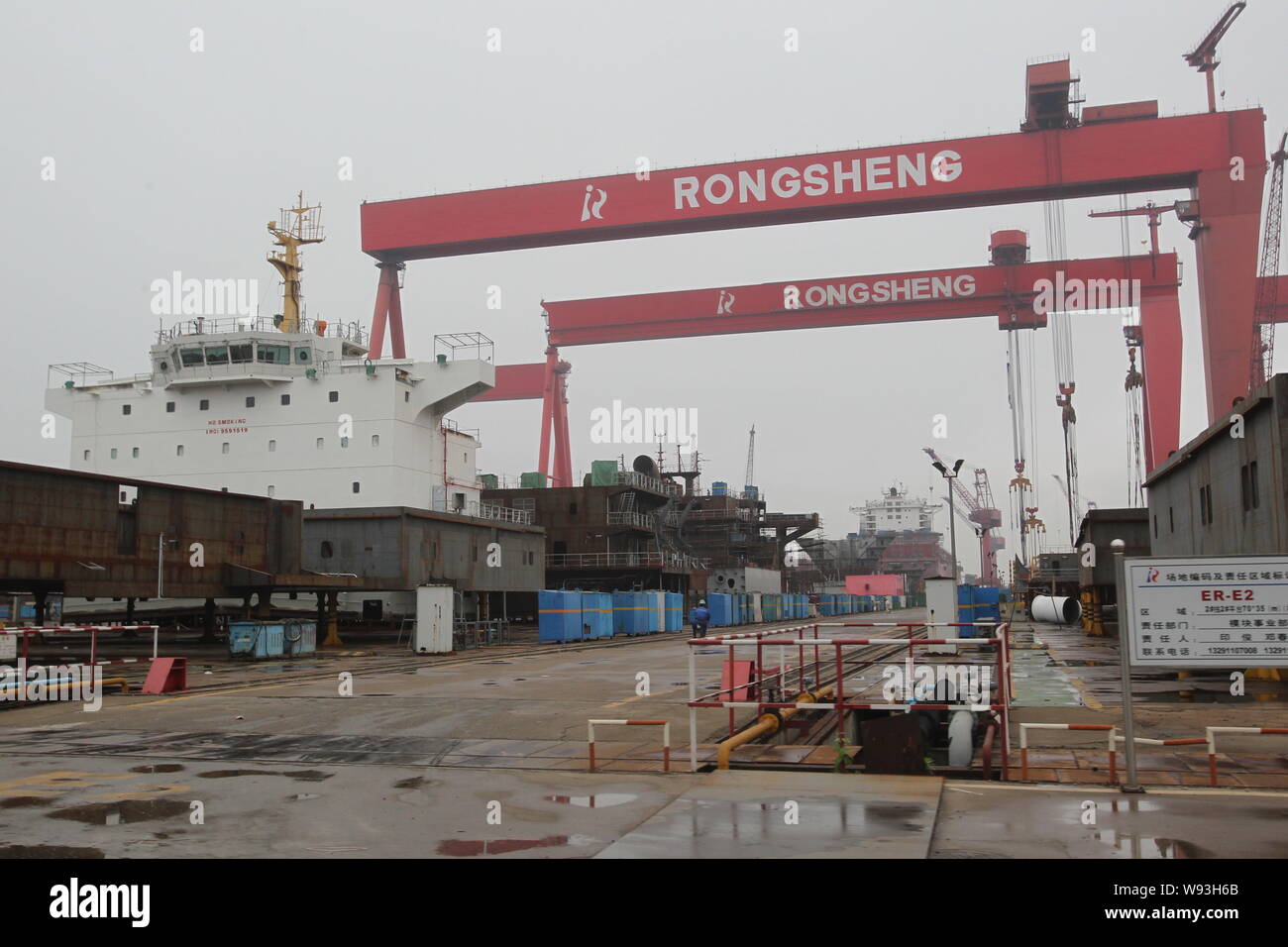
RUGAO, China/SINGAPORE (Reuters) - Deserted flats and boarded-up shops in the Yangtze river town of Changqingcun serve as a blunt reminder of the area"s reliance on China Rongsheng Heavy Industries Group, the country"s biggest private shipbuilder.A view of the Rongsheng Heavy Industries shipyard is seen in Nantong, Jiangsu province December 4, 2013. REUTERS/Aly Song
The shipbuilder this week predicted a substantial annual loss, just months after appealing to the government for financial help as it reeled from industry overcapacity and shrinking orders. Rongsheng lost an annual record 572.6 million yuan ($92 million) last year, and lost 1.3 billion yuan in the first half of this year.
While Beijing seems intent to promote a shift away from an investment-heavy model, with companies reliant on government cash injections, some analysts say Rongsheng is too big for China to let fail.
Local media reported in July that Rongsheng had laid off as many as 8,000 workers as demand slowed. Three years ago, the company had about 20,000 staff and contract employees. This week, the shipbuilder said an unspecified number of workers had been made redundant this year.
A purpose-built town near the shipyard’s main gate, with thousands of flats, supermarkets and restaurants, is largely deserted. Nine of every 10 shops are boarded up; the police station and hospital are locked.
“In this area we’re only really selling to workers from the shipyard. If they’re not here who do we sell to?” said one of the few remaining shopkeepers, surnamed Sui, playing a videogame at his work-wear store. “I know people with salaries held back and they can’t pay for things. I can’t continue if things stay the same.”
In the shadow of the shipyard gate, workers told Reuters the facility was still operating but morale was low, activity was slowing with the lack of new orders and some payments to workers had been delayed.
“Without new orders it’s hard to see how operations can continue,” said one worker wearing oil-spattered overalls and a Rongsheng hardhat, adding he was still waiting to be paid for September. He didn’t want to give his name as he feared he could lose his job.
“Morale in the office is quite low, since we don’t know what is the plan,” said a Rongsheng executive, who declined to be named as he is not authorized to speak to the media. “We have been getting orders but can’t seem to get construction loans from banks to build these projects.”
While Rongsheng has won just two orders this year, state-backed rival Shanghai Waigaoqiao Shipbuildinghas secured 50, according to shipbroker data. Singapore-listed Yangzijiang Shipbuildinghas won more than $1 billion in new orders and is moving into offshore jack-up rig construction, noted Jon Windham, head industrials analyst at Barclays in Hong Kong.
Frontline, a shipping company controlled by Norwegian business tycoon John Fredriksen, ordered two oil tankers from Rongsheng in 2010 for delivery earlier this year. It now expects to receive both of them in 2014, Frontline CEO Jens Martin Jensen told Reuters.
Greek shipowner DryShips Inchas also questioned whether other large tankers on order will be delivered. DryShips said Rongsheng is building 43 percent of the Suezmax vessels - tankers up to 200,000 deadweight tons - in the current global order book. That"s equivalent to 23 ships, according to Rongsheng data.
Speaking at a quarterly results briefing last month, DryShips Chief Financial Officer Ziad Nakhleh said Rongsheng was “a yard that, as we stated before, is facing difficulties and, as such, we believe there is a high probability they will not be delivered.” DryShips has four dry cargo vessels on order at the Chinese firm.
Rongsheng declined to comment on the Dryships order, citing client confidentiality. “For other orders on hand, our delivery plan is still ongoing,” a spokesman said.
At least two law firms in Shanghai and Singapore are acting for shipowners seeking compensation from Rongsheng for late or cancelled orders. “I’m now dealing with several cases against Rongsheng,” said Lawrence Chen, senior partner at law firm Wintell & Co in Shanghai.
Billionaire Zhang Zhirong, who founded Rongsheng in 2005 and is the shipyard"s biggest shareholder, last month announced plans to privatize Hong Kong-listed Glorious Property Holdingsin a HK$4.57 billion ($589.45 million) deal - a move analysts said could raise money to plug Rongsheng"s debts.
Meanwhile, Rongsheng’s shipyard woes have already pushed many people away from nearby centers, and others said they would have to go if things don’t pick up. Some said they hoped the local government might step in with financial support.
The Rugao government did not respond to requests for comment on whether it would lend financial or other support to Rongsheng. Annual reports show Rongsheng has received state subsidies in the past three years.
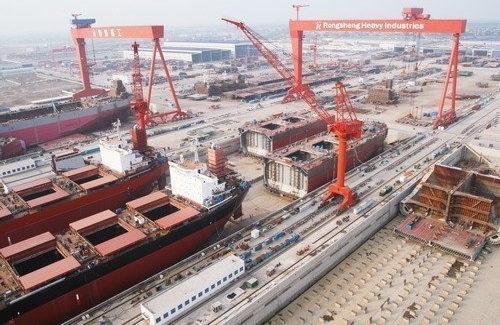
Since Beijing appears intent on telling investors it is serious about changing the investment-led growth model of the world’s second-biggest economy and controlling a credit splurge, it may seem like the writing is on the wall for China Rongsheng Heavy Industries Group.
Yet analysts say the government is more likely than not to judge that Rongsheng, which employs around 20,000 workers and has received state patronage, is too big and well connected to fail.
Supporting Rongsheng will not mean China’s economic reform plans are derailed, they say. Instead, it will mean reforms will be gradual and the government will cherry-pick firms it wants to support, which will exclude the small, private shipbuilders that have been folding in waves.
“Rongsheng is a flagship in the industry,” said Lawrence Li, an analyst with UOB Kay Hian in Shanghai. “The government will definitely provide assistance if companies like this are in trouble.”
Analysts say Rongsheng is possibly the largest casualty of a sector that has grown over the past decade into the world’s biggest shipbuilding industry by construction capacity. Amid a global shipping downturn, new orders for Chinese builders fell by half last year. In Rongsheng’s case, it won orders worth $55.6 million last year, compared with a target of $1.8 billion.
Rongsheng appealed for government aid on Friday, saying it was cutting its workforce and delaying payments to suppliers to deal with tightened cash flow.
In the prospectus for its initial public offer, Rongsheng said it received 520 million yuan of subsidies from the Rugao city government in the southern province of Jiangsu, where the company is based.
The state funds paid for research and development of new types of vessels, and were based in part on the “essential role we play in the local economy”, Rongsheng said.
Suntech Power Holdings, a solar panel maker also based in Jiangsu, is waiting to be bailed out by the government after it was crushed by falling demand and a supply glut, a source with knowledge of the matter said in March. The government wants to find a way to rescue Suntech to avoid an embarrassing collapse that damages its reputation, the source said.
As the world’s largest shipbuilder, it had 1,647 shipyards in 2012, data from China Association of the National Shipbuilding Industry showed. Over 60 percent of its shipbuilders are based in Rongsheng’s province of Jiangsu.
Despite this, the government is providing support for the industry, a sign it will also support Rongsheng given its prominence in the sector, analysts said.
Analysts say what separates Rongsheng from many other companies are its connections with the government and state banks. Rongsheng’s Chief Executive Chen Qiang, for example, enjoys “special government allowances” granted by China’s cabinet, the firm’s annual reports say.
Rongsheng also said in its IPO prospectus that it has two five-year financing deals with Export-Import Bank of China that end in 2014 and in 2015, and a 10-year agreement with Bank of China starting from 2009.
After all, local government coffers will suffer the biggest blow if Rongsheng goes bust. The firm had 168 million yuan of deferred income taxes in 2012.
“Do people expect one of the largest shipyards in the world is going to stop building ships completely with state-of-the-art, brand new facilities?” said Martin Rowe, managing director of global shipping services provider Clarkson Asia Ltd. “I think it’s highly unlikely.” (Reporting by Yimou Lee in HONG KONG and Koh Gui Qing in BEIJING; Editing by Neil Fullick)
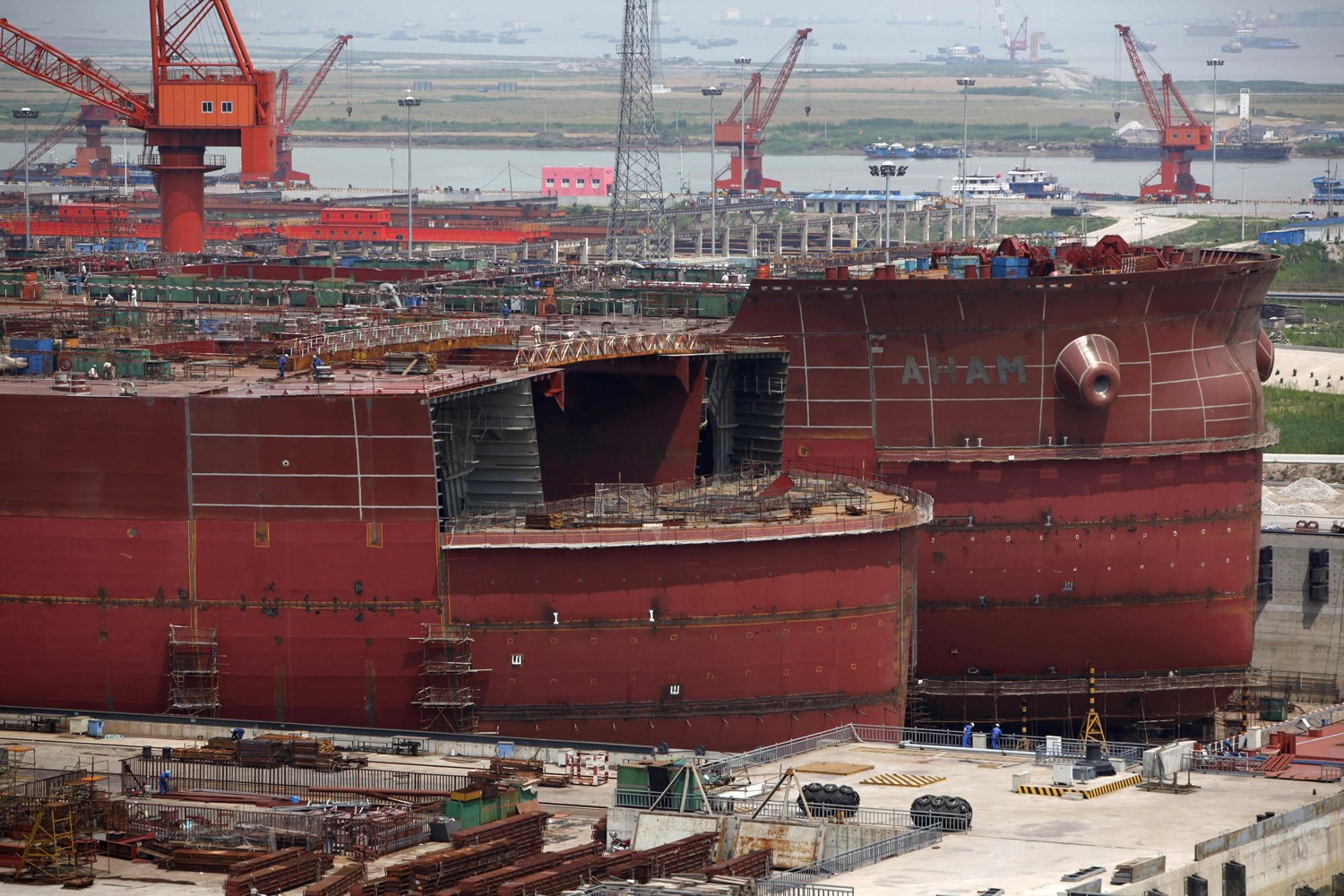
China Rongsheng Heavy Industries Group Holdings Limited is an investment holding company. The Company has four segments: shipbuilding, offshore engineering, marine engine building and engineering machinery. The Company commenced the construction of its shipyard in Nantong, Jiangsu Province. As of December 31, 2009, the Company鈥檚 shipyard covers approximately four million square meters and occupies 3,058 meters of Yangtze River shoreline. The Company operates its marine engine building business through Rong An Power Machinery. In October 2009, Rong An Power Machinery delivered its marine engine product, a Wartsila 6RT-flex68D low-speed marine diesel engine. The Company through Zhenyu Machinery offers 16 varieties of hydraulic excavators and two varieties of hydraulic crawler cranes. Its products include bulk carriers, crude oil tankers, containerships, offshore engineering products, low-speed marine diesel engines and small to mid-size excavators and cranes for construction and mining.
Ch Rongsheng isa leadinglarge-scaleheavy industry enterprisegroup.It possesses of two manufacturing bases of shipbuilding and offshore engineering in Nantong of Jiangsu Province and diesel engine in Hefei of Anhui Province both approved by NDRC, coveringwide services ranging from shipbuilding, offshoreengineering,power engineering, engineering machineryandetc. Until Dec.With thevision of “cultivate world first-class employees and create world first-class enterprise”,the spirit of “integrity-based, the pursuit of excellence”, and the responsibility ofrevitalizingnational industry, it runs fast toward the great goal of world first-class diversified heavy industry group.

--FILE--Ships are being built at a shipyard of Rongsheng Heavy Industries in Nantong city, east Chinas Jiangsu province, 24 May 2012. China Rongsheng Heavy Industries Group Holdings Ltd., the nations biggest shipyard outside state control, halted share trading on Thursday (4 July 2013) after a report the company recently pared about 8, 000 jobs. Trading of shares and all structured products related to the company was suspended pending clarification of news articles and possible inside information, Rongsheng said in filings to the Hong Kong stock exchange. The Wall Street Journal reported, citing Lei Dong, secretary to the Shanghai-based companys president, that more than half of the employees laid off were subcontractors and the rest full-time workers. Rongsheng shares slumped 10 percent on Wednesday after the company said some idled contract workers had engaged in disruptive activities by surrounding the entrance of its factory in east Chinas Jiangsu province. Chinas shipyards are suffering from a global slump in orders as a glut of vessels and slowing economic growth sap demand. Brazil and Greece accounted for more than half of Rongshengs 2012 revenue.
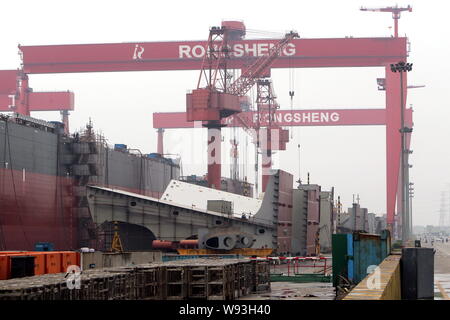
--FILE--A shipbuilding plant of China Rongsheng Heavy Industries Group Holdings Ltd is seen in Nantong city, east Chinas Jiangsu province, 23 May 2012. China Rongsheng Heavy Industries Group Holdings Ltd may report its first annual loss in four years amid a slump in the shipbuilding market. The decline in demand has led to the sharp decrease in orders and prices of vessels compared with the same period last year, Rongsheng Chinas largest private shipbuilder, said in a filing to the Hong Kong stock exchange yesterday (24 December 2012), without giving figures. The shipbuilder in August reported an 82 percent plunge in first-half earnings as a global economic slowdown and overcapacity sank demand for vessels.

The shipyard, located in the Yangtze River Delta, was founded in 2006, and became the largest private shipbuilder in China, churning out giant valemaxes at its four large dry-docks, before a massive financial collapse forced it to cease operations in 2014.
Broking sources in China tell Splash that the yard’s former chief operating officer David Luan is now preparing to officially reopen the yard, to be known as SPS Shipyard, a reference to ShipParts.com, a business he created in 2015 after quitting Rongsheng.
SPS Shipyard will start to market cape and kamsarmax slots from next week with next available slots being from Q3 2025 onwards. Luan has yet to reply to questions sent by Splash earlier today.
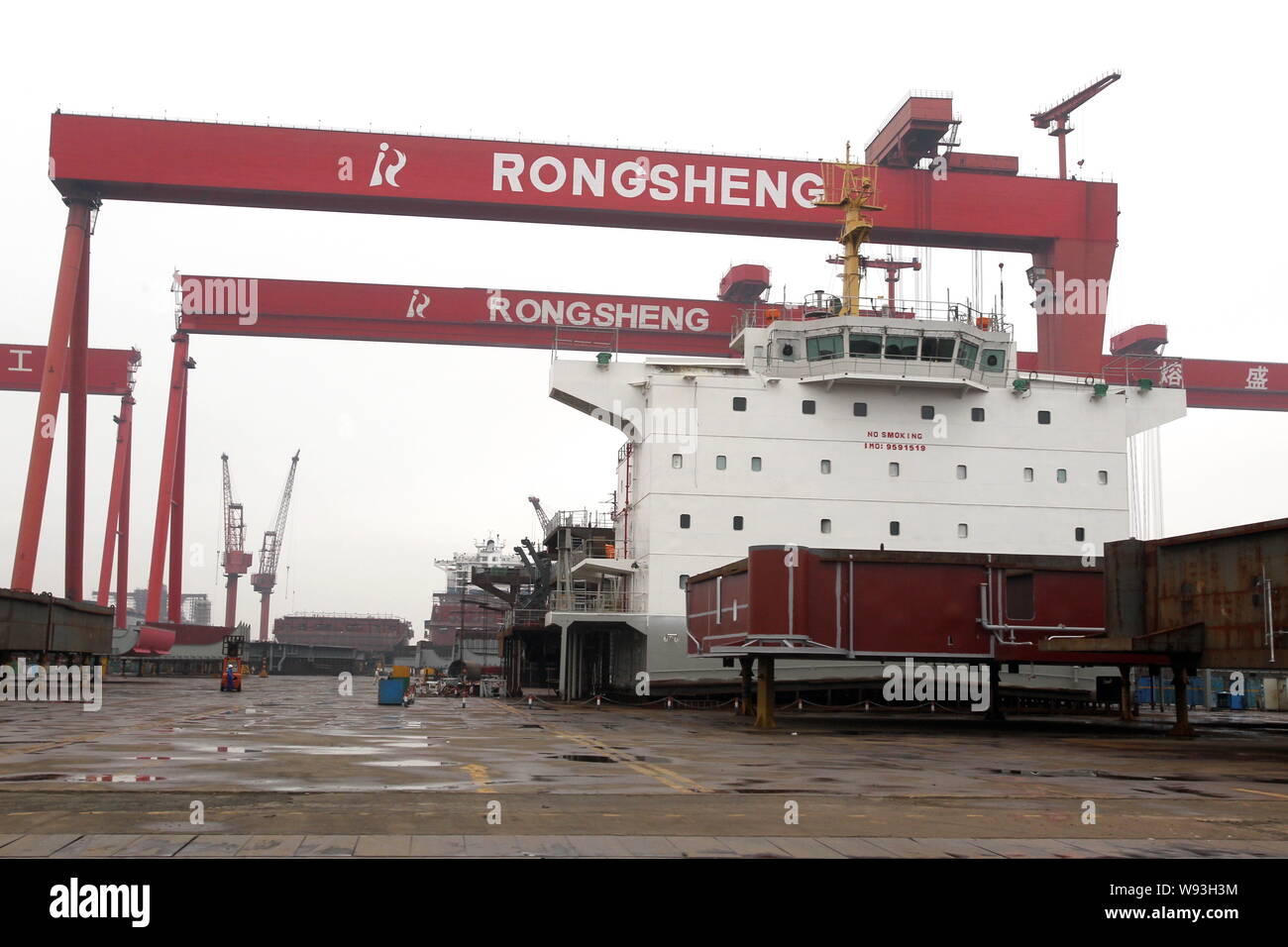
About two thousand workers at China’s biggest private shipbuilder in the eastern province of Jiangsu have clashed with police after they blockaded the plant"s entrance in protests over unpaid salary arrears, local media reports and workers said on Wednesday.
The workers from the Nantong shipyard owned by the troubled Rongsheng Heavy Industries have been on strike since Sunday after the company announced that they had to go on forced leave for a week.
The workers" strike comes after Rongsheng reported a loss of 49 million yuan (U.S.$8 million) in the first quarter of 2013, citing "the most difficult time yet" in the two recent quarters, shipping website SinoShip News said.
"The shipyard is in the middle of a transformation. We are confident and capable of solving issues in the process of the transformation," the official was quoted as saying.
Lei Dong, secretary to Rongsheng"s president, told the paper the layoffs are not a sign of financial trouble at the shipbuilder, but were rather the result of "restructuring," saying more than half the employees who were laid off were subcontractors and the remainder full-time employees.

Rongsheng Heavy Industries Group Holdings Ltd"s shares have been suspended on the Hong Kong Stock Exchange after a media report said that the company cut 8,000 jobs in recent months.
The Jiangsu-based company - China"s largest private shipyard - has been hit by a slowdown in the global shipping industry as well as sluggish domestic demand for new ships.
The company"s shares dropped 10 percent on Wednesday after it told the Wall Street Journal that some of its contract workers had engaged in "disruptive" activities and had surrounded the entrance of its factory in Jiangsu province.
Last year, Rongsheng Offshore & Marine was established in Singapore to seek new market growth points. Its business segments include shipbuilding, offshore engineering, marine engine building and engineering machinery.
"In 2011, the market was so-so, but 2012 was bad and the situation this year is cruel," said Li Aidong, president of Daoda Heavy Industry Group, an 8,000-worker shipyard in Jiangsu.
"Chinese shipyards of all sizes have been hit hard in the past two years, and they often lack the technology and bank loans needed to produce the sophisticated vessels sought in many new orders," Li said.
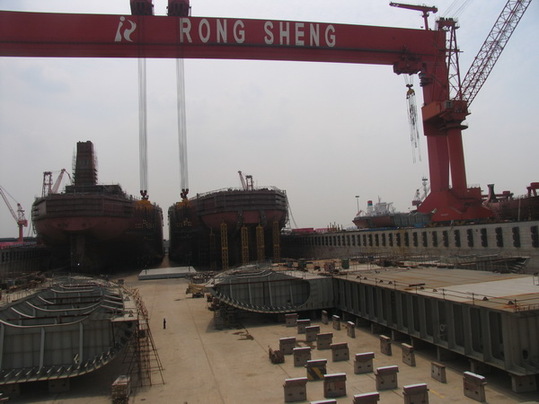
As hard times continue in the shipbuilding industry, former giant Rongsheng is in deep financial trouble. The company hopes a move into the energy sector can change its fortunes, but analysts are skeptical.
Amid dark times in the global shipbuilding industry, another of China"s major players appears to be on the verge of bankruptcy. China Rongsheng Heavy Industries Group used to be the largest private shipbuilder in the country, but is now seeking potential buyers to help get it out of deep financial problems.
In the past few months, many workers have left Rongsheng"s plant in Nantong, East China"s Jiangsu Province, which stopped production after it delivered a ship to Brazilian iron ore giant Vale in January, Caixin magazine reported on March 9.
The once-busy plant in Nantong used to have as many as 30,000 workers, but now "only several thousand of them are still there," a Rongsheng employee who declined to be named told the Global Times on Tuesday.
The employee has been working at Rongsheng for more than five years, but said he will also be leaving the company soon. Having watched the ups and downs of Rongsheng, he said he will not be staying in the shipbuilding industry either. "It has been such a sad story for the industry," he said.
No more plain sailingRongsheng was founded by entrepreneur Zhang Zhirong in 2005, when the shipbuilding industry was booming. The initial designed annual capacity of the plant in Nantong was as much as 3.5 million dead weight tons, nearly the same as the total annual capacity of State-owned China State Shipbuilding Corp at that time, according to the Caixin report.
But the global shipbuilding industry found itself in a severe recession when the world economy was hit by the financial crisis in 2008. Many private shipbuilders went bankrupt in the ensuing years, but even then few people thought the same fate would befall Rongsheng.
Many shipbuilders became very cautious about accepting new orders under these circumstances, given the huge amounts of capital needed to build a ship. But Rongsheng did the opposite and increased its orders. The Caixin report said that Rongsheng gained the most orders among all shipbuilders in China from 2010 to 2012.
"Good order figures may have helped the financing, but Rongsheng should have been more cautious about expanding during an overall industry downturn," Wang Danqing, a partner at Beijing-based ACME Consultancy, told the Global Times on Tuesday.
The Rongsheng employee said that poor management has also been a major factor behind Rongsheng"s predicament. Deliveries of many of the orders have been delayed, giving ship buyers the option of abandoning the order and claiming compensation.
Seeking a way outRongsheng has been trying to diversify in order to get over the current difficulties, and is now preparing for a move into the energy sector. The company announced on Friday that its board of directors had agreed to change its name to China Huarong Energy Co, according to a filing with the Hong Kong bourse.
Wang Shaojian, Rongsheng"s chief financial officer, told the media he was "confident" in the prospects for Rongsheng in the energy sector. The company has already started making moves in this regard. In August 2014, it announced that it had acquired a 60 percent stake in a subsidiary of New Continental Oil & Gas (HK) Co in Kyrgyzstan, giving Rongsheng equity in an oil field in the country.
Wu noted that Rongsheng may lack the expertise and talent required for the oil industry, adding that it will have to compete with even bigger rivals in the sector.
Rongsheng is also trying to streamline its business. It said in a filing on Tuesday that it has signed a memorandum with a potential buyer for it to acquire Rongsheng"s shipbuilding and ocean engineering business, as well as its debts.
Yangzijiang Shipbuilding declined to comment on the matter when contacted by the Global Times on Wednesday. Rongsheng also declined to comment, saying that it is now in a "quiet period," prior to further announcements.
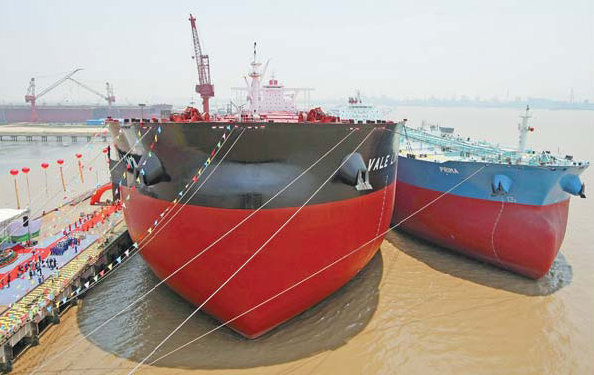
The shipyard of China Rongsheng Heavy Industries Group Holdings Ltd in Rugao, Jiangsu province. The company will generate HK$2.55 billion ($326.4 million) in a share sale in the next six months and HK$3.23 billion thereafter. [Provided to China Daily]
China Rongsheng Heavy Industries Group Holdings Ltd, the private-sector shipbuilder that had sought financial assistance, has secured cash for restructuring and announced changing the company"s name as it shifts focus to energy.
Shifting its focus to oil will need a lot more funds, which Rongsheng already struggled to get as a shipbuilder, said Francis Lun, chief executive officer of Geo Securities Ltd.
In September the Jiangsu shipyard unit was listed among 51 shipbuilding facilities in China deemed worthy of policy support as the industry grapples with overcapacity.
Rongsheng said it has now received the results of an appraisal by an independent assessor, which will be used as the basis for the restructuring in which it also plans to change its name to China Huarong Energy Co to more accurately reflect its expansion and new business scope.
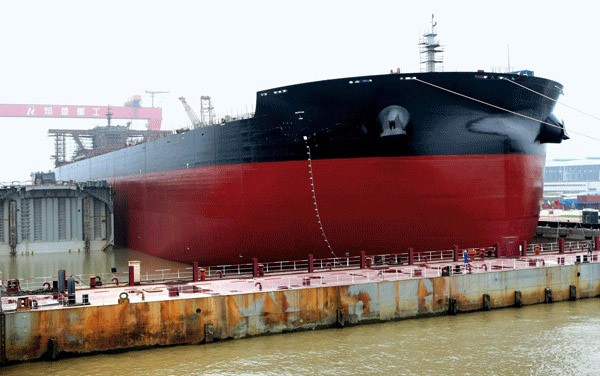
In 2008, Vale placed orders for twelve 400,000-ton Valemax ships to be constructed by Jiangsu Rongsheng Heavy Industries (RSHI) in China and ordered seven more ships from South Korean Daewoo Shipbuilding & Marine Engineering (DSME) in 2009. In addition sixteen more ships of similar size were ordered from Chinese and South Korean shipyards for other shipping companies, and chartered to Vale under long-term contracts. The first vessel was delivered in 2011 and the last in 2016.
The first Valemax vessels were ordered on 3 August 2008 when Vale signed a contract with the Chinese shipbuilder Jiangsu Rongsheng Heavy Industries (RSHI) for the construction of twelve 400,000-ton ore carriers. The development had reportedly started in 2007.
The first Chinese-built Valemax vessel, Vale China, was launched at the Nantong shipyard on 9 July 2011 and delivered on 25 November 2011.Valemax vessel would call a Chinese port on its maiden voyage,
The second RSHI-built Valemax ship for Vale (Vale Dongjiakou) was delivered on 9 April 2012,Vale Dalian) on 20 May,Vale Hebei) on 28 September,Vale Shandong) on 7 December 2012,Vale Jiangsu) on 23 March 2013,Vale Caofeidian) on 22 July 2013,Vale Lianyungang) on 22 November 2013,Ore Majishan; renamed before delivery) on 11 July 2014,Ore Tianjin; renamed before delivery) on 18 October 2014,Ore Rizhao; renamed before delivery) on 15 December 2014.Valemax vessel of the original order by Vale, Ore Ningbo (renamed before delivery), was delivered on 23 January 2015.
The Chinese shipbuilder"s ability to deliver any of the very large ore carriers ordered by Vale in time was doubted already before the first ship was built.Valemax vessels will be delivered from the Chinese shipyard in 2011 instead of the planned six due to delays in construction.Vale China) was delivered before the end of the year. Furthermore, later reports claimed that the ships ordered by Vale had a capacity of only 380,000 tons even though according to the Det Norske Veritas database entries all Chinese-built ships have a deadweight tonnage in excess of 400,000 tons and in the past Vale has referred to the ships ordered from Rongsheng as "400,000-ton" vessels. The reduction in cargo capacity, at least on paper, may have been due to the reluctance of Chinese officials to accept the 400,000-ton ships to Chinese ports.
In April 2012, it was reported that Vale had refused delivery for three Valemax ships recently completed by Jiangsu Rongsheng Heavy Industries. This was seen as a move against the Chinese officials who have not allowed the 400,000-ton ships to dock in Chinese ports.
In March 2016, it was reported that three Chinese companies China Ocean Shipping (Group) Company (COSCO), China Merchants Energy Shipping and Industrial and Commercial Bank of China (ICBC) had ordered ten Valemax vessels each from four Chinese shipyards with a total price of US$2.5 billion.Valemax ships ordered by China Merchants Energy Shipping would be built by Shanghai Waigaoqiao Shipbuilding (4 ships), Qingdao Beihai Shipbuilding (4 ships), and China Merchants Group-controlled China Merchants Heavy Industry (Jiangsu) (2 ships).Yangzijian Shipbuilding while the remaining four would be awarded to Qingdao Beihai Shipbuilding.Valemax vessels, Yuan He Hai, was delivered on 11 January 2018
The cause of the damage has not been published by STX, but design or construction flaws, material fatigue and incorrect loading have all been suspected.Vale Beijing remained anchored off Ponta da Madeira with a crawler crane on the deck and an oceangoing tug standing bySão Luís for Oman. After unloading at Sohar, the ship headed to South Korea for dry docking and arrived at STX shipyard in Jinhae, where it was delivered in September 2011, for inspection and repairs on 21 April 2012.Vale Beijing returned to service in July 2012.
After the incident, the China Shipowners" Association (CSA) questioned the safety of the 400,000-ton ore carriers commissioned by Vale. CSA was particularly concerned about the ability of the newly built ships to withstand various sea conditions and the pollution resulting from fuel oil leaks in case of structural damageValemax ship can carry around 10,000 tons of fuel oil.port of Lianyungang in the Jiangsu province.
Vale Sohar, built by Jiangsu Rongsheng Heavy Industries (RSHI), awaiting delivery for Oman Shipping Company in Nantong, China, in September 2012. Note the minor differences to the South Korean-built Vale Rio de Janeiro.
Luiz Inácio Lula da Silva, the former president of Brazil, also publicly criticized Vale"s former CEO Roger Agnelli for the decision of ordering ships from Asian shipyards instead of building them in Brazil, where Lula da Silva has been trying to revitalize the shipbuilding industry to create more jobs and increase local demand for steel and other products. Agnelli, who later left his position following continued criticism, replied that the Brazilian shipyards did not have the capacity to build such ships and stated that during the past few years Vale had commissioned 51 vessels from Brazilian shipyards.




 8613371530291
8613371530291